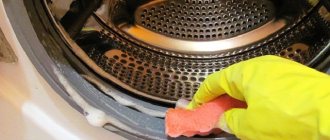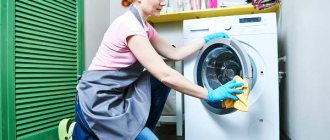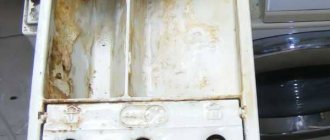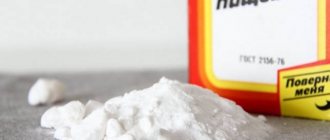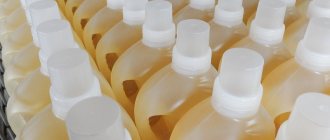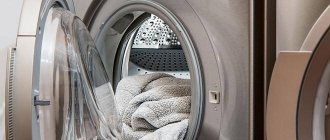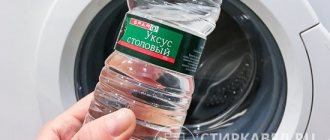Any equipment, including household appliances, requires care! Without timely cleaning, the service life of the washing machine (even if it seems to you that it does a good job without your help) is reduced. Let's figure out how to quickly and effectively clean a washing machine with your own hands.
Important! Before taking any action, carefully read the operating manual of the washing machine and familiarize yourself with the manufacturer's recommendations and warranty statements.
How to clean an iron at home: 6 ways
How to clean a cuff in the washing machine
The rubber cuff (or more simply put, rubber) is a real breeding ground for germs, fungus and mold, so caring for it affects the service life of the drum itself. It is best to wipe moisture from the cuff after each wash, which will make it easier to care for in the future.
To wash the cuff, apply a solution of detergent to it and scrub it thoroughly with a sponge, making sure to avoid hard-to-reach areas, and then wipe dry. In case of really serious contamination, the rubber seal can be removed, but we strongly recommend that you only do this if you are confident that you can do it correctly. Usually the cuff is attached from the outside with a wire clamp, which can be pryed off with a screwdriver by moving it in a circle. The inner part of the cuff is usually attached to the tank using a spring; when dismantling, it can be removed along with it. You can wash the gum in a basin in water with the addition of bleach. It is important to keep in mind that removing the cuff is still somewhat easier than putting it back in place, so do not experiment if you are not confident in your abilities.
How to clean a frying pan outside and inside: 6 tips and life hacks for different pans
Prevention
The main points that should be adhered to in order to maintain the original appearance and functionality of the automatic machine:
- Pour/pour in the amount of powder/conditioner specified by the manufacturer, no more. If you use more detergent than needed, your clothes will not get cleaner. While the excess funds will settle in the car.
- Be sure to take change out of your pockets.
- Do not leave dirty or freshly washed items in the drum for a long time.
- Try to leave the door open to avoid creating favorable conditions inside for mold to grow.
How to clean a washing machine drum
Formally, it is believed that high-quality cleaning of the drum should be carried out at least once every couple of months. The problem is that at high temperatures scale forms (especially with a high level of water hardness), and at low temperatures bacteria and fungi thrive. Therefore, no matter what washing modes you choose, the drum will still require care and attention from you.
Prohibited tricks
In order not to cause irreparable harm or damage the washing machine during cleaning, you need to know about several taboos.
- Never wash a machine that is connected to an electrical outlet.
- It is forbidden to wash the washing machine under water pressure, so do not use a spray bottle or shower hose for this purpose.
- Do not use household chemicals that are not intended for cleaning an automatic washing machine.
- The use of abrasive or aggressive cleaning agents such as solvents is prohibited.
- Never clean electrical components yourself, especially the motor. Do not expose them to water.
- Some home craftsmen clean heating elements with sandpaper. Doing this is strictly prohibited!
Don't forget to unplug your washing machine before washing.
How to clean the powder and conditioner tray in a washing machine
The detergent drawer is a particularly vulnerable area. If you ignore litter box maintenance, at some point you will find plaque, rust and mold inside it. Accumulated dirt and detergent residues impede the movement of water through the compartment, so the quality of the wash will suffer, not to mention the fact that mold can be harmful to health.
Most containers in the area of the air conditioner compartment have a special tab that you need to press on and at the same time pull the tray towards you. However, for some brands everything is much more complicated (for example, if the detergent compartment does not pull out like a drawer, but like a fan). Under no circumstances try to remove the tray using brute force - there is a risk of simply breaking it. If you do not know how to remove the dispenser and the instruction manual does not help or does not contain such information, it is better to limit cleaning to the inside of the container without attempting to remove it.
You can get rid of dirt using an old toothbrush and a mild cleanser. If you managed to remove the tray, you can first soak it in a soapy solution in a basin and then clean it with a brush. Folk remedies will help you cope with stubborn mold stains: vinegar or vinegar with soda - moisten a cotton pad and apply the mixture to the stains. If you pulled out the tray, take a look inside before putting it back. Mold and plaque may also be found there, which again a toothbrush will help you reach.
When finished cleaning, wipe all parts with a dry cloth.
Cleaning with folk remedies
When cleaning your washing machine regularly, you can use folk remedies that are used in the household. They are not always effective in removing old stains.
Among the folk remedies, the following stand out.
Citric acid
You can clean it with this budget-friendly product; moreover, it is not required to clean a large amount. The chemical composition of lemon juice is capable of destroying scale that has accumulated inside the washer and on the seal.
When cleaning, in order to avoid negative phenomena, it is important to observe the correct dosage. A device with a 5-kilogram load requires 100 g of acid.
Procedure:
1. Load citric acid into the powder receptacle. If you need better cleaning of the drum, you can load two equal doses - one into the receiver, the other directly into the drum.
2. Select the full cycle mode with the temperature set to 90°C.
3. At the end of the process, wipe all surfaces of the machine with a clean cloth.
4. Leave the powder receptacle and the manhole cover open until the smell of acid has completely disappeared and is completely dry.
5. If there is any remaining dirt, repeat cleaning.
Vinegar
A solution of acetic acid with a concentration suitable for household use (table vinegar) is used for descaling.
The technological process for removing lime deposits is similar to those using citric acid.
The disadvantage of a strong odor creates difficulties for the user, which requires protective equipment in the form of masks and gloves.
It is very easy to clean a washing machine of any model (Samsung, LG, Zanussi, ARGO, Electrolux, Whirlpool, Beko, Bosch, Haier, Hotpoint Ariston, Ariston, Ardo, Gorenje, Dexp, Siemens and others) with vinegar.
Soda
Baking soda is always on hand as it is used in the kitchen for cooking.
Used to clean the washing machine in one of the following ways:
1. Mix with water in a 1:1 ratio (a tablespoon of soda to a tablespoon of water). Bring the mixture to a mushy state.
2. Apply the mixture to the surface of a damp soft sponge. Use it to thoroughly wipe all accessible areas of household appliances (drum, seal, inner surface of the tray, etc.).
3. You should wait (about 20-30 minutes). During this time, a mixture of soda and water will maximally destroy the continuity of existing contaminants.
4. In the quick wash mode followed by setting the rinse mode, wash off the decomposed residues of dirt.
Cleaning with sodium percarbonate
Oxygen bleach, the main component of which is sodium percarbonate, is much safer than chlorine-containing bleaches for washing machine elements.
Liquid bleach "White" after several uses as a detergent will turn the sealing rubber into a solid material. Its effectiveness is higher than that of baking soda. The methods of using sodium percarbonate powder and soda are similar.
How to clean the washing machine drain filter
This filter is located on the front side of the washing machine in its lower part (left or right). Typically, the filter is hidden behind a removable panel or small hatch. It is really necessary to clean it, since fabric fibers, large debris and dirt can become trapped in it. Over time, the water will not completely drain from the machine, and the clothes will remain wetter after spinning.
To clean the filter, turn off the power and turn off the water supply. Before removing the filter, prepare a basin and a rag - there is always water in the drain system. Remove the filter and clean any large debris, then wash the filter with a coarse sponge under running warm water. Be sure to check the hole in the machine and also clean it of any remaining debris, dirt and plaque. Then return the filter to its place, making sure that it fits in without distortion, and tighten the filter plug. Don’t forget to plug in the machine immediately after installation and check for leaks using a test rinse. If not a drop has leaked out from under the filter cover, you can replace the closing panel.
How to clean a microwave: 3 super ways for different stains + life hack for cleaning the door
Removing hairs from the hatch cuff
Debris often gets stuck between the folds of the rubber seal, and pet hair is no exception. Folding back the bottom edge of the cuff, you can see the hair “balls” that have accumulated there. It is convenient to clean the gasket with a regular damp cloth, which fits into a narrow space without any problems.
Sometimes intensive treatment of the cuff can be performed. Apply a little white to the sponge and wipe the surface of the rim with it. Next, you need to close the hatch door and wait half an hour for the best effect of the product. Then the seal should be washed with a cloth soaked in clean water and wiped dry.
Do not clean the drum cuff with household chemicals containing caustic acids.
Aggressive components damage the rubber seal. In addition, such chemicals are dangerous to humans and can cause hand skin irritation and allergies.
Step-by-step instruction
Well, shall we begin? To make the instructions clear, we decided to try the theory in practice and cleaned a Bosch automatic washing machine. Looking ahead, we present you with a photo of the result.
